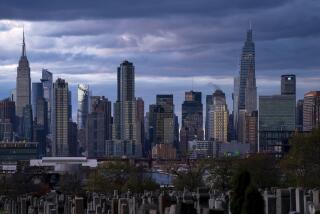NYC mayor’s latest? Put health food on chip racks, move junk food
- Share via
Just as New Yorkers are adjusting to the idea of doing without super-sized sugary sodas, those on the hunt for fattening food and drink could be facing another hurdle. Shoppers in some markets will have to walk past -- gasp -- apples, bananas and other healthful items before they reach the junk.
It’s all part of Mayor Michael R. Bloomberg’s drive to combat obesity in New York City, a fight that has the backing of many health and nutrition experts but is a thorn in the zaftig sides of people who say they should be able to eat and drink what they want.
Bloomberg announced the latest move Wednesday, just days before the city’s Board of Health holds a public hearing on his proposal to ban super-sized sodas from sale at most restaurants, delis, cinemas and sports venues. That proposal targets sugary sodas of 16 ounces or more.
People who can’t endure a movie or meal without those 54 teaspoons of sugar and 780 calories in the average 64-ounce drink will be able to dodge the rule by buying multiple smaller sodas. Bloomberg says he’s hoping that extra step will make consumers think twice about what they’re drinking and discourage them from going for seconds. Or thirds, fourths and fifths.
Making people work harder for their junk food is also behind the newest idea, Shop Healthy NYC, which will have participating grocers in the city’s unhealthiest borough -- Bronx -- stocking and displaying healthful food and produce at eye-level on shelves normally housing chips and sodas. That includes the stands at the checkout counter -- the ones normally laden with candy and other easy-to-grab snacks.
“Lasting change can be slow, but daily decisions as simple as buying an apple instead of a sugary beverage can have positive long-term health impacts,” the deputy mayor for health and human services, Linda Gibbs, said in a statement.
The city says scores of markets in two Bronx neighborhoods, Fordham and West Farms, have agreed to take part in the voluntary program; it could reach more than 130,000 people who shop in those stores. Two major suppliers of food to city markets will work with participating shops to offer discounts on healthy foods.
Bronx was selected for the pilot program because nearly 70% of its residents are obese or overweight, according to the city’s health commissioner, Thomas Farley.
Bloomberg launched the city’s Obesity Task Force in January as statistics showed that 58% of city residents were obese or overweight. Nearly 40% of public school children in kindergarten through eighth grade are overweight or obese.
Those statistics, combined with soaring diabetes rates and other health problems, haven’t convinced everyone that the soda ban is a good idea, and the July 24 public hearing on the proposed rule is likely to bring out scores of speakers pro and con. Opponents argue, among other things, that it’s not fair to target sugary sodas without also taking a look at drinks sold in places like Starbucks, some of which are more like milkshakes than coffee and which are laden with fat and calories.
Because the newest effort involving the Bronx stores is voluntary, it hasn’t generated nearly the outcry that the proposed soda ban did, but those weighing in on The Call Blog, of the all-news station NY1, appeared to be leaning against the idea.
Several said shoppers are forced by economics to buy less healthful food, because they say it’s cheaper than fresh produce. Others said they opposed the latest plan because they view it as another attempt by Bloomberg -- who has also targeted smoking, trans-fats and salt -- to take over their lives.
“What’s next on Emperor Bloomberg’s agenda? Having waiters take out a blood pressure cuff before allowing someone to order a salty meal?” a commenter called Simone posted on the blog.
ALSO:
Food’s sticker shock: A look at drought and crop damage
Chick-fil-A’s anti-gay-marriage stance triggers online uproar
Lawn chair pilots: Balloons kept taking us up -- and into storm
More to Read
Sign up for Essential California
The most important California stories and recommendations in your inbox every morning.
You may occasionally receive promotional content from the Los Angeles Times.











